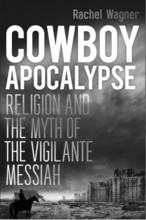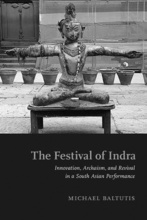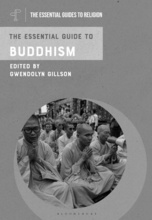Breadcrumb
Alumni Books
Cowboy Apocalypse
By Rachel Wagner

In the midst of widespread mass shootings in America, a common motif stands out: the perpetrators of these attacks often view themselves as vigilante saviors, whose job it is to regulate society in a way that exterminates their enemies.
In this fascinating critique, Rachel Wagner makes the case that this unfortunate phenomenon is best understood through the idea of the cowboy apocalypse. She shows that across much US media, from video games and blockbuster movies to novels and TV, a story arc has been created that provides a complete myth about the end of the world and the future after that. In these stories, the cowboy messiah is envisioned as a good guy with a gun. But he doesn’t save the world. He just saves his world: he protects his family and
others he deems worthy while embracing the chance to wipe the global slate clean and start fresh, with survivors testing their mettle on a new frontier.
Wagner illuminates the links between Christian apocalypticism, American gun culture, and the romanticization of the white male-dominated American frontier, showing how the vigilante has come to be regarded as a new savior figure, out to protect the world for white supremacy and patriarchy. She also offers ways
to respond with other powerful cultural myths, making use of media to tell other stories. Cowboy Apocalypse offers a new means of making sense of how guns profoundly shape American life, and how we might engage with them otherwise.
The Production of Consumers and the Formation of Desire
A Neo-Thomist Perspective
By Christine Darr

We live in a society surrounded by stuff and bombarded with advertisements that try to convince us that shopping will improve our lives. Sometimes our lives do improve, yet our purchases are more often motivated by an impulse to satisfy immediate desires rather than reflective deliberation about how our purchasing choices enable us to live the lives we want. Christian moral reflection often criticizes this conundrum as “mindless consumerism,” arguing that it pulls Christians away from loving God above all things. While such critiques often encourage Christians to focus their desire on God rather than material goods, we might still wonder how we can exercise such control over our desires. By attending to desire itself ─ how it arises, how it is shaped by social context, and its role in cultivating a virtuous life ─ we can learn how to desire and then act in ways that are more consonant with our conception of what it means to live well. Within the Christian tradition, Thomas Aquinas offers a compelling model of human desire that, when juxtaposed with Pierre Bourdieu’s theory of social practices, can help us make more considered judgments about how to navigate the consumer society in which we live.
The Festival of Indra
Innovation, Archaism, and Revival in a South Asian Performance
By Michael Baltutis

The Festival of Indra details the textual and performative history of an important South Asian festival and its role in the development of classical Hinduism. Drawing on various genres of Sanskrit textual sources—especially the epic Mahābhārata—the book highlights the innovative ways that this annual public festival has supported the stable royal power responsible for the sponsorship of these texts. More than just a textual project, however, the book devotes significant ethnographic attention to the only contemporary performance of this festival that adheres to the classical Sanskrit record: the Indrajatra of Kathmandu, Nepal. Here, Indra’s tall pole remains the festival’s focal point, though its addition of the royal blessing by Kumari, the “living goddess” of Nepal, and the regular presence of the fierce god Bhairav show several significant ways that ritual agents have re-constructed this festival over the past two thousand years.
The Essential Guide to Buddhism
By Gwendolyn Gillson (Anthology Editor)

Beginning with an overview of Buddhism, this book explores the religion’s origins in northern India and Nepal, through to its development and spread across Asia, to its vibrant and sometimes contradictory present. The book covers key topics in the study of Buddhism, including its rituals and its scriptures, meditation and monasticism, and death and afterlife. The book also includes contemporary issues such as Buddhism and economics and socially engaged Buddhism.